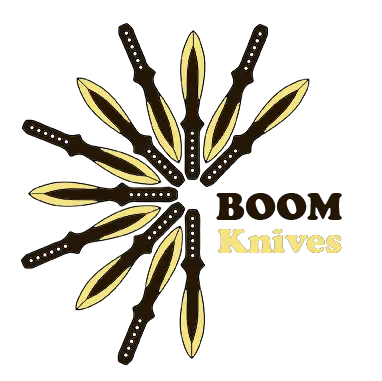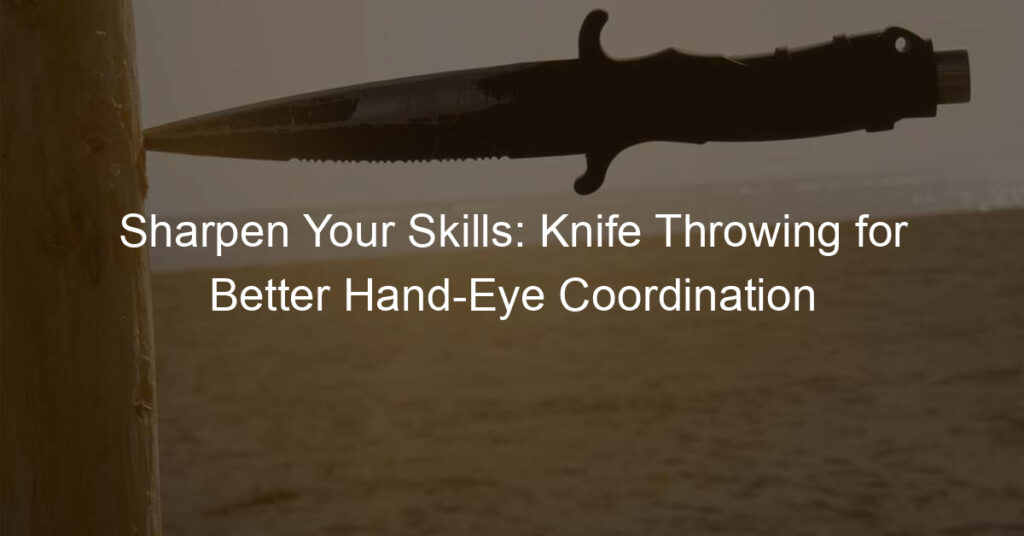Introduction to Knife Throwing
Knife throwing, a skill that has been practiced for centuries, is more than just a hobby. It’s an art form, a sport, and a valuable survival skill. This article will introduce you to the fascinating world of knife throwing, providing insights into its history, techniques, and safety measures. Whether you’re a beginner or an experienced thrower, there’s always something new to learn.
-
- Understanding the Art of Knife Throwing
It’s not about strength, but about technique. The thrower must be able to control the rotation of the knife and accurately hit the target. This art has been practiced for centuries, originally for hunting and warfare, and now as a sport and hobby. Learn more about the art of knife throwing on Wikipedia.
-
- Why Knife Throwing is a Valuable Skill
Knife throwing is not just a fun pastime, it’s a valuable skill. It can help improve hand-eye coordination, focus, and patience. In a survival situation, it can be a lifesaving skill. Furthermore, the discipline and control required in knife throwing can be applied to other areas of life, making it a beneficial hobby to pursue.
-
- Overview of the Article
We’ll start by helping you discover your knife throwing style, then move on to different throwing techniques. We’ll discuss the types of throwing knives, safety precautions, and training methods. We’ll also delve into the history of knife throwing and even look at how you can participate in knife throwing competitions. So, whether you’re just starting out or looking to improve your skills, this article has something for you.
Discovering Your Knife Throwing Style
-
- Identifying your natural throwing style
Some people prefer a straight, direct throw, while others might have a more curved or angled approach. To identify your natural style, you need to throw the knife without thinking too much about the technique. Pay attention to your body movements, the way you hold the knife, and the trajectory of your throws. This will give you a good idea of your natural throwing style.
-
- Experimenting with different techniques
Try out different grips, stances, and throwing methods. You can learn a lot from professional knife throwers and their techniques. The goal is not to copy someone else’s style, but to find what works best for you.
-
- Adapting styles to suit your strengths
Maybe you’re more accurate with a certain grip, or perhaps a specific stance gives you more power. Use this knowledge to adapt your style to your strengths. This will not only improve your accuracy and power but also make knife throwing more enjoyable for you.
Knife Throwing Techniques
Basic Techniques for Beginners
-
- Understanding the Grip
It’s about how you hold the knife. A firm but relaxed grip is ideal. The handle should rest lightly in your hand, with your fingers wrapped around it. The thumb should be placed on the top, not too tight, to allow the knife to release smoothly from your hand. A too tight grip can hinder the knife’s rotation and affect your throw’s accuracy.
-
- Perfecting the Stance
Stand upright, with your feet shoulder-width apart, and your dominant foot slightly forward. Your body should be aligned with the target. This stance provides balance and allows for a full range of motion when you throw the knife.
-
- Mastering the Throw
It involves a smooth, fluid motion. Start with your arm fully extended behind you, then bring it forward in a swift, controlled motion. Release the knife when your arm is almost fully extended towards the target. Mastering the throw, so don’t be discouraged if you don’t get it right immediately.
Knife throwing is a skill that takes time and practice to master. Don’t rush the process. Instead, focus on understanding and perfecting these basic techniques. With patience and persistence, you’ll see improvement in your knife throwing abilities.
Advanced Techniques for Professionals
-
- Throwing Multiple Knives
It’s not just about throwing more than one knife at a time, but also about maintaining accuracy and control. This technique can be practiced by starting with two knives and gradually increasing the number as you gain confidence and precision.
-
- Throwing from Different Distances
Another advanced technique that can significantly improve your skills. Start by marking different distances from your target and practice throwing from each mark. This will help you understand how the distance affects your throw and how to adjust your technique accordingly. The key here is consistency and practice.
-
- Throwing at Moving Targets
It requires excellent timing, precision, and quick decision-making. Start with slow-moving targets and gradually increase the speed as you become more comfortable. This technique can be a fun way to test your skills and improve your reaction time.
Types of Throwing Knives
There are various types of throwing knives available in the market, each with its unique design and purpose. Understanding these different designs, choosing the right knife for your style, and knowing the pros and cons of each type can significantly improve your knife throwing skills.
-
- Understanding Different Knife Designs
-
-
- Blade-heavy knives: These knives have a heavier blade than handle, making them ideal for beginners as they are easier to control.
- Handle-heavy knives: These knives have a heavier handle, which can provide a different throwing experience.
- Balanced knives: These knives have an equal weight distribution, making them a popular choice among professional throwers. Learn more about balanced knives here.
- Choosing the Right Knife for Your Style
-
Choosing the right throwing knife depends on your throwing style, personal preference, and level of experience. Beginners might find blade-heavy knives easier to handle, while more experienced throwers might prefer the precision of balanced knives. It’s important to try out different types and choose the one that feels the most comfortable and suits your style best.
-
- Pros and Cons of Different Knife Types
Each type of throwing knife has its advantages and disadvantages. Here’s a quick overview:
| Type of Knife | Pros | Cons |
|---|---|---|
| Blade-heavy knives | Easy to control, ideal for beginners | Limited throwing techniques |
| Handle-heavy knives | Offers a different throwing experience | Requires more skill to control |
| Balanced knives | Allows for a variety of throwing techniques, preferred by professionals | Requires more practice to master |
Understanding the different types of throwing knives and their pros and cons can help you make an informed decision about which knife to choose.
Knife Throwing Safety
-
- Importance of safety in knife throwing
An exciting and challenging sport, but it can also be dangerous if not done correctly. The importance of safety in knife throwing cannot be overstated. A single mistake can lead to serious injuries. According to the Wikipedia, there have been reported cases of injuries due to improper handling and throwing of knives. Therefore, it’s crucial to learn and follow safety guidelines at all times.
-
- Essential safety gear
This includes a sturdy pair of gloves to protect your hands, safety glasses to shield your eyes from any potential flying debris, and closed-toe shoes to protect your feet. Additionally, it’s also advisable to use a knife throwing target board that’s designed to absorb the impact of the knife, reducing the risk of ricochet.
-
- Safe practice techniques
Always ensure that the area around you is clear before you throw a knife. Never throw a knife towards a person or an animal. It’s also important to maintain a proper distance from the target. The Wikipedia suggests a minimum safe distance of at least 10 feet. Always handle the knife by the handle, not by the blade.
Knife throwing is a thrilling sport that requires skill, precision, and most importantly, a strong emphasis on safety. By understanding the importance of safety, wearing the right gear, and practicing safe techniques, you can enjoy this sport while minimizing the risk of injury.
Knife Throwing Training
Self Training
- Setting up a practice area: Your practice area should be spacious and free from obstructions. A wooden target board is ideal for practice. Ensure the area is safe and there’s no risk of injury to others. For more information on how to set up a practice area, visit Wikipedia’s page on knife throwing.
- Creating a training routine: Consistency is key in mastering knife throwing. Dedicate specific hours each day for practice. Start with basic throws and gradually move to complex techniques.
- Tracking progress and improvement: Keep a record of your daily practice. Note the number of successful throws, the distance, and the techniques used. This will help you identify areas of improvement and track your progress over time.
Professional Training
-
Finding a Professional Trainer
Finding a professional trainer who specializes in knife throwing can be a bit of a challenge. However, it’s worth the effort. You can start your search online or by asking for recommendations from people in the knife throwing community. Ensure that the trainer has a good reputation, solid experience, and a teaching style that suits you. You can also check out the Knife Throwing page on Wikipedia for more information.
-
Benefits of Professional Training
It provides structured learning, which can help you progress faster. A professional trainer can correct your technique, preventing bad habits from forming. They can also provide safety instructions and tips to prevent injuries. Moreover, a trainer can offer personalized advice and encouragement, which can boost your confidence and motivation.
-
What to Expect in a Training Session
During a training session, you can expect to learn about different knife throwing techniques and safety procedures. The trainer will demonstrate each technique and then guide you as you practice. You’ll also learn how to set up a practice area and maintain your throwing knives. Each session will likely end with a review of what you’ve learned and a preview of what’s to come in the next session.
Knife Throwing Competitions
- Understanding competition rules
Often include specifications about the type of knives to be used, the distance from the target, and the scoring system. For example, the International Knife Throwing Hall of Fame (IKTHOF) uses a point system where the bullseye earns the thrower 5 points, the second ring 4 points, and so on. Understanding these rules is crucial for any competitor.
- Preparing for a competition
Physically, competitors need to practice their throwing techniques and aim. Mentally, they need to build focus and concentration. It’s also important to familiarize oneself with the competition rules and the type of knives to be used. A good tip is to practice with the same type of knife that will be used in the competition.
- Case study: Famous knife throwing competitions
There are many famous knife throwing competitions around the world. One of the most prestigious is the World Knife Throwing Championship (WKTC). This competition attracts the best knife throwers from all over the globe and is known for its high standards and intense competition. In 2019, the WKTC was won by John Bailey, a renowned knife thrower who demonstrated exceptional skill and precision.
History of Knife Throwing
-
- Origins of Knife Throwing
Can be traced back to prehistoric times. Early humans used sharp objects as hunting tools and weapons for protection. The ability to throw these tools accurately was a matter of life and death. Over time, these primitive tools evolved into the throwing knives we know today. The practice of knife throwing was further developed by various cultures around the world, including the Native Americans, African tribes, and even the Samurai warriors of Japan. For more detailed information, you can visit this Wikipedia page.
-
- Evolution of Throwing Techniques
Initially, knife throwing was a survival skill, and techniques were based on practicality and effectiveness. As time passed, knife throwing became a form of entertainment and sport. This shift led to the development of various throwing styles and techniques, such as the spin throw, the no-spin throw, and the instinctive throw. Each technique requires a different level of skill and practice, making knife throwing a diverse and exciting sport.
-
- Historical Significance of Knife Throwing
A significant role in various cultures and periods. In ancient times, it was a vital survival skill. In some cultures, it was a rite of passage for young men. In the Middle Ages, knife throwing became a popular form of entertainment at fairs and festivals. Today, it is a recognized sport with competitions held worldwide. The historical significance of knife throwing is a testament to its enduring appeal and the skill it requires.
Conclusion
- Recap of Key Takeaways: We’ve journeyed through the world of knife throwing, from its history to the various techniques and styles. We’ve learned about the importance of safety, the different types of throwing knives, and how to train effectively. We’ve also explored the competitive side of this fascinating sport. The key takeaway is that knife throwing is a skill that requires practice, precision, and a deep understanding of the tools and techniques involved. More about knife throwing on Wikipedia.
- Encouragement for Continued Practice: Like any skill, knife throwing requires consistent practice. Don’t get discouraged if you don’t hit the target on your first, second, or even hundredth try. Even the most accomplished knife throwers started from scratch. Keep practicing, stay patient, and you’ll see improvement over time.
- Final Thoughts on Knife Throwing: Knife throwing is more than just a hobby—it’s a discipline that requires focus, precision, and a respect for safety. Whether you’re interested in it for sport, self-defense, or simply as a fun pastime, knife throwing can be a rewarding and exciting skill to learn.







